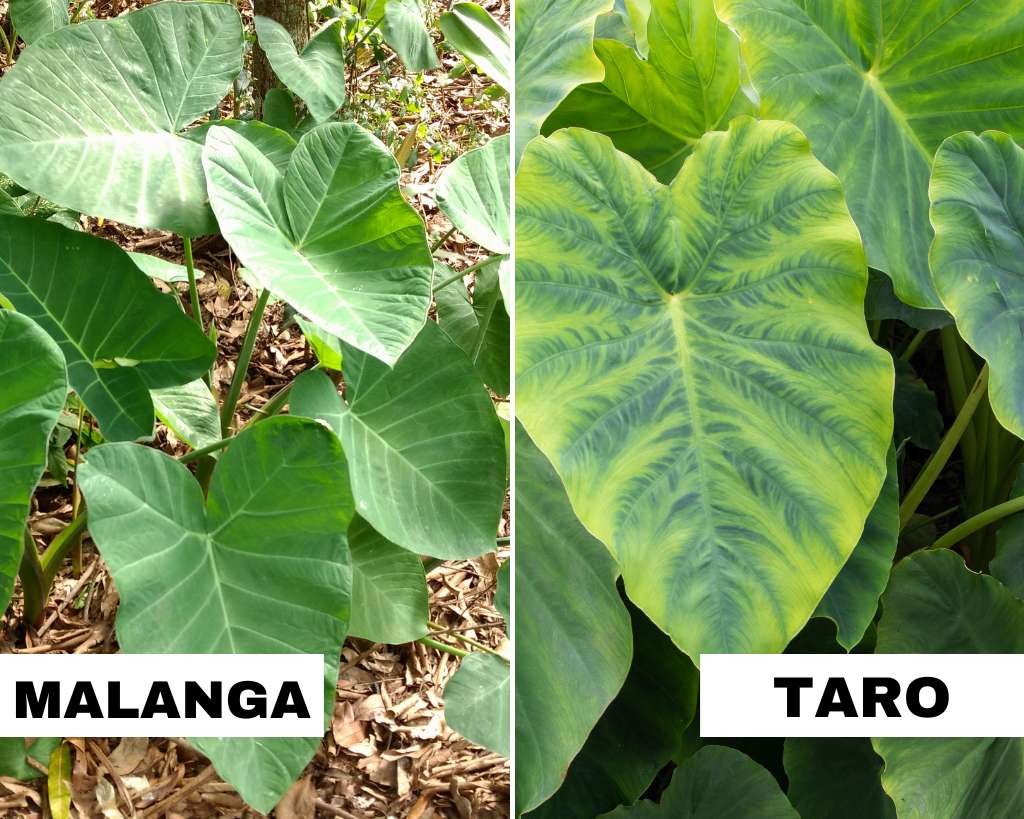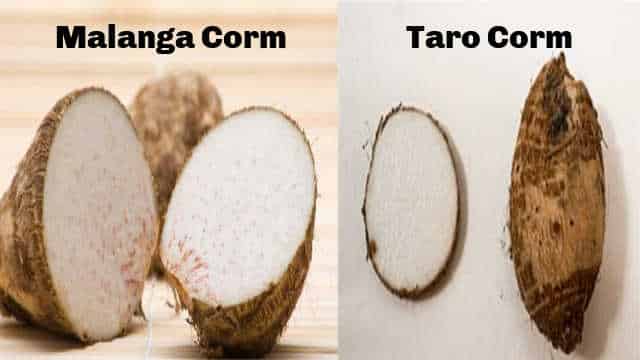Malanga and Taro are both tubers that are popular in tropical regions. Both of these starchy vegetable plants are known for their roots and cormlets. They are often used interchangeably in different recipes.
It is widely believed that Taro and Malanga are the same plants, but they have different names. They are members of the Araceae family. They share some unique similarities and differences, which we will discuss further in this article.
Malanga vs Taro – Key Differences & Similarities

Now, we will discuss all the important aspects of “Malanga vs Taro” to find out which one will be the best option for you to grow in your garden.
Plant Size
Malanga typically grows to a height of 1-2 meters, with large, tropical-looking leaves that can be up to 1 meter in length. The underground root, or corm, can grow up to 15 centimeters in diameter and can weigh up to 1 kilogram.
Taro has tropical-looking leaves that can reach 1-2 meters in height. Taro corm can be much larger than that of malanga, sometimes reaching 30 centimeters in diameter and weighing up to several kilograms.
Stems

The stem of malanga is long and slender, with a light green color. Its stem is thicker than malanga’s, and it has a dark purple hue.
The stem of both plants can grow up to several feet tall and have a fibrous texture. Additionally, the stems of both plants often have small spines along their length, which can be either short and stubby or long and thin depending on the variety of the plant.
Leaves

Malanga leaves are typically dark green color and have a glossy surface. They are also quite large, growing up to 2 feet in length and 14 inches in width. The edges of the leaves are wavy and they have prominent veins running across them.
Taro leaves, on the other hand, are much lighter in color than malanga leaves. They range from light green to purple-tinged gray and have a matte texture. The edges of taro leaves tend to be smooth instead of wavy like malanga, and their veins are less pronounced. Additionally, taro leaves are usually smaller than malanga, reaching only about 1 foot in length and 8 inches in width.
Malanga vs Taro – Corms

The color of malanga corm can vary depending on the variety of plants. Generally, the corms are a light brown or tan color. However, some varieties can have green, purple, or even black corms.
The taro corm’s texture is smoother compared to the Malanga corm’s hairy texture.
The color of taro corms can vary depending on the variety of taro plants. The most common colors are white, yellow, pink, and purple. The color of the corms is not an indicator of the plant’s maturity or nutritional value.
Taro corm has a bulb-shaped structure that is different from the Malanga corm, which looks like a thinner, more extended version of a potato.
The flesh of taro corm is the edible part of the plant, typically white or light purple. Pinkish dots can also be seen inside the taro corm.
The flesh color of malanga corms can vary depending on the variety of plants. Some malanga corms have white flesh, while others have yellow, orange, or even pink flesh. The color of the flesh is not always an indicator of the quality of the corm, but it can be an indication of sweetness.
Taste
The taste of malanga corm is unique and has been described as earthy, nutty, and slightly sweet. It is often compared to the taste of potato or yam.
The taste of taro corm is often described as nutty or earthy. Some also say it has a slightly sweet taste. The exact flavor will depend on the variety of taro corm you are eating and how it is prepared.
Additionally, the corms and leaves of both veggies should be cooked before consumption. Eating it raw can cause some issues due to the presence of calcium oxalate compound. Rhubarb leaves also have the same compound that makes their leaves inedible. Boiling them can help eliminate the chemical.
Nutritional Value
| Nutrient | Malanga(100 grams cooked) | Taro(100 grams cooked) |
| Calories | 128 | 116 |
| Total Fat | 0.3 g | 0.3 g |
| Protein | 2 g | 2.3 g |
| Total Carbs | 31 g | 25 g |
| Cholesterol | 0 mg | 0 mg |
| Potassium | 358 mg | 485 mg |
Both malanga and taro are nutritious, low calorie options that can be a healthy addition to a balanced diet.
Lifespan
Malanga and taro are typically grown as perennials in tropical and subtropical regions. When grown in the right conditions, they can live for several years and produce crops year after year. Under ideal conditions, malanga and taro plants can live for up to 5-7 years.
However, when grown in less favorable conditions, the lifespan of these plants can be shorter, and they may not produce as many crops. Environmental factors, such as drought, flooding, and pest and disease infestations, can also impact the lifespan of malanga and taro plants.
Harvesting
Harvesting of malanga usually takes place about 8-10 months after planting, when the foliage has begun to yellow. The plants should be dug up carefully to avoid damaging the roots. The roots should then be cleaned, and the tops trimmed off.
Taro is usually harvested about 9-12 months after planting, when the leaves begin to yellow. The plants should be carefully dug up, taking care not to damage the roots. The leaves should be trimmed off, and the roots should be cleaned.
It’s important to take necessary precautions while harvesting these crops, as some varieties of taro contain toxic compounds in their stems and leaves and must be properly prepared before consumption. Additionally, both malanga and taro can cause skin irritation in some individuals, so gloves are recommended while handling them.
Can malanga and taro be substituted for each other in recipes?
Malanga and taro can be substituted for each other in some recipes, but there may be differences in taste and texture.
What are some common dishes that use malanga and taro?
Taro chips: Thin slices of taro root are fried until crispy and served as a snack or side dish.
Malanga fufu: A popular dish in Caribbean and African cuisine, malanga is boiled, mashed, and served as a side dish with stews and soups.





[…] Also Read: Malanga vs Taro […]